Want to catch up with other articles from this series?
- The straight dope on cholesterol – Part I
- The straight dope on cholesterol – Part II
- The straight dope on cholesterol – Part III
- The straight dope on cholesterol – Part IV
- The straight dope on cholesterol – Part V
- The straight dope on cholesterol – Part VI
- The straight dope on cholesterol – Part VII
- The straight dope on cholesterol – Part VIII
- The straight dope on cholesterol – Part IX
Previously, across 8 parts of this series we’ve laid the groundwork to ask perhaps the most important question of all:
What should you eat to have the greatest chance of delaying the arrival of cardiovascular disease?
Before we get there, since this series has been longer and more detailed than any of us may have wanted, it is probably worth reviewing the summary points from the previous posts in this series (or you can just skip this and jump to the meat of this post).
What we’ve learned so far
- Cholesterol is “just” another fancy organic molecule in our body but with an interesting distinction: we eat it, we make it, we store it, and we excrete it – all in different amounts.
- The pool of cholesterol in our body is essential for life. No cholesterol = no life.
- Cholesterol exists in 2 forms – unesterified or “free” (UC) and esterified (CE) – and the form determines if we can absorb it or not, or store it or not (among other things).
- Much of the cholesterol we eat is in the form of CE. It is not absorbed and is excreted by our gut (i.e., leaves our body in stool). The reason this occurs is that CE not only has to be de-esterified, but it competes for absorption with the vastly larger amounts of UC supplied by the biliary route.
- Re-absorption of the cholesterol we synthesize in our body (i.e., endogenous produced cholesterol) is the dominant source of the cholesterol in our body. That is, most of the cholesterol in our body was made by our body.
- The process of regulating cholesterol is very complex and multifaceted with multiple layers of control. I’ve only touched on the absorption side, but the synthesis side is also complex and highly regulated. You will discover that synthesis and absorption are very interrelated.
- Eating cholesterol has very little impact on the cholesterol levels in your body. This is a fact, not my opinion. Anyone who tells you different is, at best, ignorant of this topic. At worst, they are a deliberate charlatan. Years ago the Canadian Guidelines removed the limitation of dietary cholesterol. The rest of the world, especially the United States, needs to catch up. To see an important reference on this topic, please look here.
- Cholesterol and triglycerides are not soluble in plasma (i.e., they can’t dissolve in water) and are therefore said to be hydrophobic.
- To be carried anywhere in our body, say from your liver to your coronary artery, they need to be carried by a special protein-wrapped transport vessel called a lipoprotein.
- As these “ships” called lipoproteins leave the liver they undergo a process of maturation where they shed much of their triglyceride “cargo” in the form of free fatty acid, and doing so makes them smaller and richer in cholesterol.
- Special proteins, apoproteins, play an important role in moving lipoproteins around the body and facilitating their interactions with other cells. The most important of these are the apoB class, residing on VLDL, IDL, and LDL particles, and the apoA-I class, residing for the most part on the HDL particles.
- Cholesterol transport in plasma occurs in both directions, from the liver and small intestine towards the periphery and back to the liver and small intestine (the “gut”).
- The major function of the apoB-containing particles is to traffic energy (triglycerides) to muscles and phospholipids to all cells. Their cholesterol is trafficked back to the liver. The apoA-I containing particles traffic cholesterol to steroidogenic tissues, adipocytes (a storage organ for cholesterol ester) and ultimately back to the liver, gut, or steroidogenic tissue.
- All lipoproteins are part of the human lipid transportation system and work harmoniously together to efficiently traffic lipids. As you are probably starting to appreciate, the trafficking pattern is highly complex and the lipoproteins constantly exchange their core and surface lipids.
- The measurement of cholesterol has undergone a dramatic evolution over the past 70 years with technology at the heart of the advance.
- Currently, most people in the United States (and the world for that matter) undergo a “standard” lipid panel, which only directly measures TC, TG, and HDL-C. LDL-C is measured or most often estimated.
- More advanced cholesterol measuring tests do exist to directly measure LDL-C (though none are standardized), along with the cholesterol content of other lipoproteins (e.g., VLDL, IDL) or lipoprotein subparticles.
- The most frequently used and guideline-recommended test that can count the number of LDL particles is either apolipoprotein B or LDL-P NMR, which is part of the NMR LipoProfile. NMR can also measure the size of LDL and other lipoprotein particles, which is valuable for predicting insulin resistance in drug naïve patients, before changes are noted in glucose or insulin levels.
- The progression from a completely normal artery to a “clogged” or atherosclerotic one follows a very clear path: an apoB containing particle gets past the endothelial layer into the subendothelial space, the particle and its cholesterol content is retained, immune cells arrive, an inflammatory response ensues “fixing” the apoB containing particles in place AND making more space for more of them.
- While inflammation plays a key role in this process, it’s the penetration of the endothelium and retention within the endothelium that drive the process.
- The most common apoB containing lipoprotein in this process is certainly the LDL particle. However, Lp(a) and apoB containing lipoproteins play a role also, especially in the insulin resistant person.
- If you want to stop atherosclerosis, you must lower the LDL particle number. Period.
- At first glance it would seem that patients with smaller LDL particles are at greater risk for atherosclerosis than patients with large LDL particles, all things equal.
- “A particle is a particle is a particle.” If you don’t know the number, you don’t know the risk.
- With respect to laboratory medicine, two markers that have a high correlation with a given outcome are concordant – they equally predict the same outcome. However, when the two tests do not correlate with each other they are said to be discordant.
- LDL-P (or apoB) is the best predictor of adverse cardiac events, which has been documented repeatedly in every major cardiovascular risk study.
- LDL-C is only a good predictor of adverse cardiac events when it is concordant with LDL-P; otherwise it is a poor predictor of risk.
- There is no way of determining which individual patient may have discordant LDL-C and LDL-P without measuring both markers.
- Discordance between LDL-C and LDL-P is even greater in populations with metabolic syndrome, including patients with diabetes. Given the ubiquity of these conditions in the U.S. population, and the special risk such patients carry for cardiovascular disease, it is difficult to justify use of LDL-C, HDL-C, and TG alone for risk stratification in all but the most select patients.
- To address this question, however, one must look at changes in cardiovascular events or direct markers of atherosclerosis (e.g., IMT) while holding LDL-P constant and then again holding LDL size constant. Only when you do this can you see that the relationship between size and event vanishes. The only thing that matters is the number of LDL particles – large, small, or mixed.
- HDL-C and HDL-P are not measuring the same thing, just as LDL-C and LDL-P are not.
- Secondary to the total HDL-P, all things equal it seems smaller HDL particles are more protective than large ones.
- As HDL-C levels rise, most often it is driven by a disproportionate rise in HDL size, not HDL-P.
- In the trials which were designed to prove that a drug that raised HDL-C would provide a reduction in cardiovascular events, no benefit occurred: estrogen studies (HERS, WHI), fibrate studies (FIELD, ACCORD), niacin studies, and CETP inhibition studies (dalcetrapib and torcetrapib). But, this says nothing of what happens when you raise HDL-P.
- Don’t believe the hype: HDL is important, and more HDL particles are better than few. But, raising HDL-C with a drug isn’t going to fix the problem. Making this even more complex is that HDL functionality is likely as important, or even more important, than HDL-P, but no such tests exist to “measure” this.
Did you say “delay?”
That’s right. The question posed above did not ask how one could “prevent” or eliminate the risk cardiovascular disease, it asked how one could “delay” it. There is a difference. To appreciate this distinction, it’s worth reading this recent publication by Allan Sniderman and colleagues. Allan sent me a copy of this paper ahead of publication a few months ago in response to a question I had posed to him over lunch one day. I asked,
“Allan, who has a greater 5-year risk for cardiovascular disease, a 25 year-old with a LDL-P/apoB in the 99th percentile or a 75-year-old with a LDL-P/apoB in the 5th percentile?”
The paper Allan wrote is noteworthy for at least 2 reasons:
- It’s an excellent reminder that age is a paramount risk factor for cardiovascular disease.
- It provides a much better (causal) model for atherosclerosis than the typical age-driven models, and explains why age is an important risk factor.
What do I mean by this? Most risk calculators (e.g., Framingham) take their inputs (e.g., age, gender, LDL-C, HDL-C, smoking, diabetes, blood pressure) and calculate a 10-year risk score. If you’ve ever played with these models you’ll quickly see that age drives risk more than any other input. But why? Is there something inherently “risky” about being older?
Sniderman and many others would argue (and I agree) that the reason age is a strong predictor of risk has to do with exposure to apoB particles — LDL, Lp(a), and apoB-carrying remnants. Maybe it’s because I’m a math geek, but such models just seem intuitive to me because I think of most things in life in terms of calculus, especially integrals, the “area under a curve.”
[I once tried to explain to a girlfriend who thought I wasn’t spending enough time with her that my interest in her should be thought of in terms of the area under the curve, rather than any single point in time. That is, think in terms of the integral function, not the point-in-time function. Needless to say, she broke up with me on the spot (in the middle of a parking lot!), despite me drawing a very cool picture illustrating the difference, which I’ve re-created, below.]
The reason age is such a big driver of risk is that the longer your artery walls are exposed to the insult of apoB particles, the more likely they are to be damaged, for all the reasons we covered in Part IV of this series. [This paper also reviews the clinical situation of PCSK9 mutations which builds a very compelling case for the causal model of apoB particles in the development of atherosclerosis].
What does eating have to do with cardiovascular risk?
So now that everyone is on the edge of their seat in anticipation of this punch-line, let me provide two important caveats.
First, there are no long-term studies – either in primary or secondary prevention – examining the exact question we all want to know the answer to with respect to the role of dietary intervention on cardiovascular disease. There are short-term studies, some of which I will highlight, which look at proxies for cardiovascular disease, but all of the long-term studies (looking at secondary prevention), are either drug studies or multiple intervention studies (e.g., cholesterol-lowering drug(s) + blood pressure reducing drug(s) + dietary intervention + exercise + …).
In other words, the “dream” study has not been done and won’t be done for a long time. The “dream” study would follow 2 randomized groups for many years and only make one change between the groups. Group 1 would consume a standard American diet and group 2 would consume a very-low carbohydrate diet. Furthermore, compliance within each group would be excellent (many ways to ensure this, but none of them are inexpensive – part of why this has not been done) and the study would be powered to detect “hard outcomes” (e.g., death), instead of just “soft outcomes” (e.g., changes in apoB, LDL-C, LDL-P, TG).
Second, everything we have learned to date on the risk relationship between cardiovascular disease and risk markers is predicated on the assumption that a risk maker of level X in a person on diet A is the same as it would be for a person on diet B.
Since virtually all of the thousands of subjects who have made up the dozens of studies that form the basis for our understanding on this topic were consuming some variant of the “standard American diet” (i.e., high-carb), it is quite possible that what we know about risk stratification is that this population is not entirely fit for extrapolation to a population on a radically different diet (e.g., a very-low carbohydrate diet or a ketogenic diet). Many of you have asked about this, and my comments have always been the same. It is entirely plausible that an elevated level of LDL-P or apoB in someone consuming a high-carb diet portends a greater risk than someone on a ketogenic or low-carb diet. There are many reasons why this might be the case, and there are many folks who have made compelling arguments for this hypothesis.
But we can’t forget the words of Thomas Henry Huxley, who said, “The great tragedy of science is the slaying of a beautiful hypothesis by an ugly fact.” Science is full of beautiful hypothesis slayed by ugly facts. Only time will tell if this hypothesis ends up in that same graveyard, or changes the way we think about lipoproteins and atherosclerosis.
The role of sugar in cardiovascular disease
Let’s start with what we know, then fill in the connections, with the goal of creating an eating strategy for those most interested in delaying the onset of cardiovascular disease.
There are several short-term studies that have carefully examined the impact of sugar, specifically, on cardiovascular risk markers. Let’s examine one of them closely. In 2011 Peter Havel and colleagues published a study titled Consumption of fructose and HFCS increases postprandial triglycerides, LDL-C, and apoB in young men and women. If you don’t have access to this journal, you can read the study here in pre-publication form. This was a randomized trial with 3 parallel arms (no cross-over). The 3 groups consumed an isocaloric diet (to individual baseline characteristics) consisting of 55% carbohydrate, 15% protein, and 30% fat. The difference between the 3 groups was in the form of their carbohydrates.
Group 1: received 25% of their total energy in the form of glucose
Group 2: received 25% of their total energy in the form of fructose
Group 3: received 25% of their total energy in the form of high fructose corn syrup (55% fructose, 45% glucose)
The intervention was relatively short, consisting of both an inpatient and outpatient period, and is described in the methodology section.
Keep in mind, 25% of total energy in the form of sugar is not as extreme as you might think. For a person consuming 2,400 kcal/day this amounts to about 120 pounds/year of sugar, which is slightly below the average consumption of annual sugar in the United States. In that sense, the subjects in Group 3 can be viewed as the “control” for the U.S. population, and Group 1 can be viewed as an intervention group for what happens when you do nothing more in your diet than remove sugar, which was the first dietary intervention I made in 2009.
Despite the short duration of this study and the relatively small number of subjects (16 per group), the differences brought on by the interventions were significant. The figure below shows the changes in serum triglycerides via 3 different ways of measuring them. Figure A shows the difference in 24-hour total levels (i.e., the area under the curve for serial measurements – hey, there’s our integral function again!). Figure B shows late evening (post-prandial) differences. Figure C shows the overall change in fasting triglyceride level from baseline (where sugar intake was limited for 2 weeks and carbohydrate consumption consisted only of complex carbohydrates).
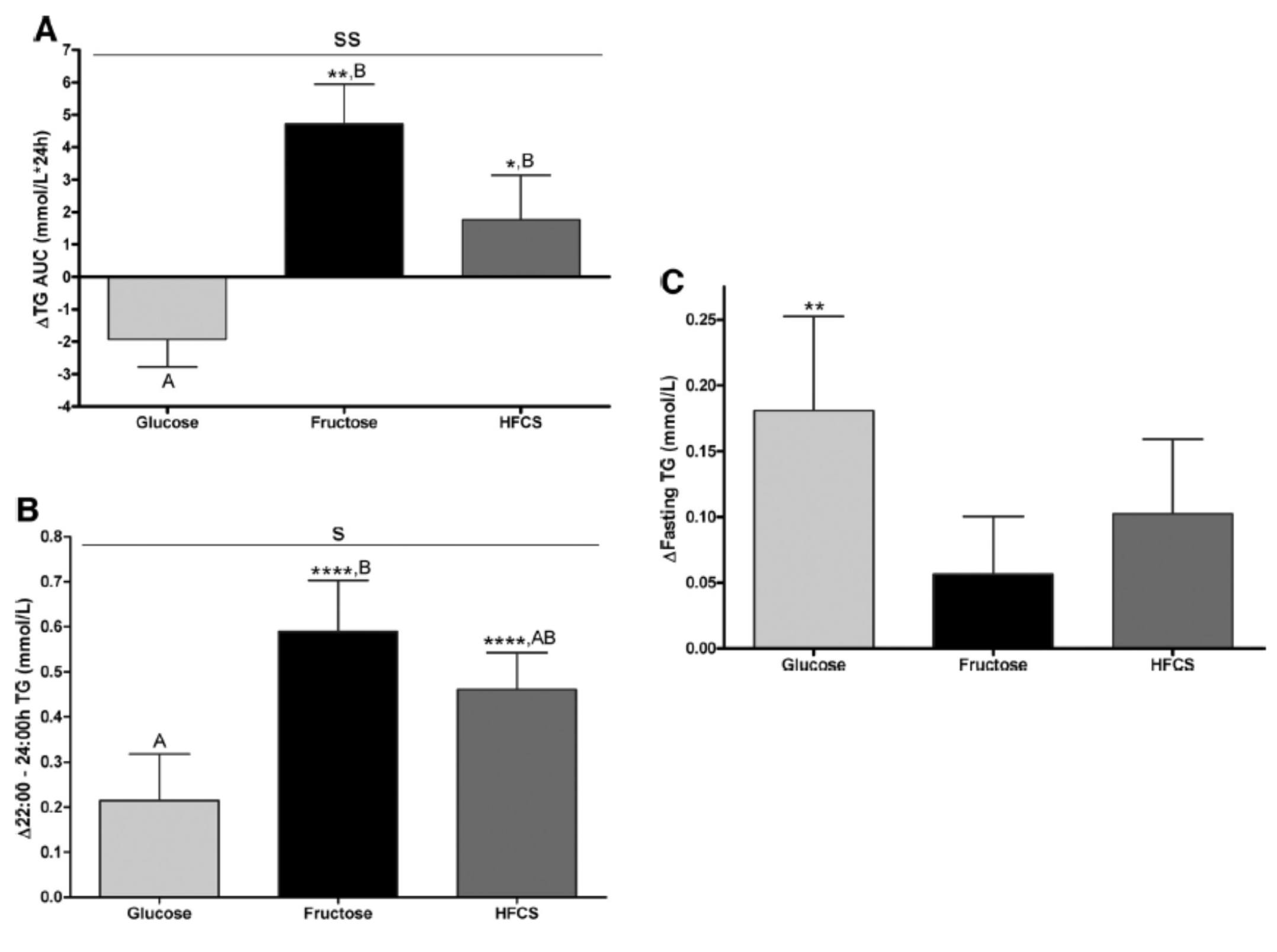
The differences were striking. The group that had all fructose and HFCS removed from their diet, despite still ingesting 55% of their total intake in the form of non-sugar carbohydrates, experienced a decline in total TG (Figure A, which represents the daily integral of plasma TG levels, or AUC). However, that same group experienced the greatest increase in fasting TG levels (Figure C). Post-prandial TG levels were elevated in all groups, but significantly higher in the fructose and HFCS groups (Figure B). The question this begs, of course, is which of these measurements is most predictive of risk?
Historically, fasting levels of TG are used as the basis of risk profiling (Figure C), and according to this metric glucose consumption appears even worse than fructose or HFCS. However, recent evidence suggests that post-prandial levels of TG (Figure B) are a more accurate way to assess atherosclerotic risk, as seen here, here, and here. One question I have is why did the AUC calculations in Figure A show a reduction in plasma TG level for the glucose group?
The figure below summarizes the differences in LDL-C, non-HDL-C, apoB, and apoB/apoA-I.
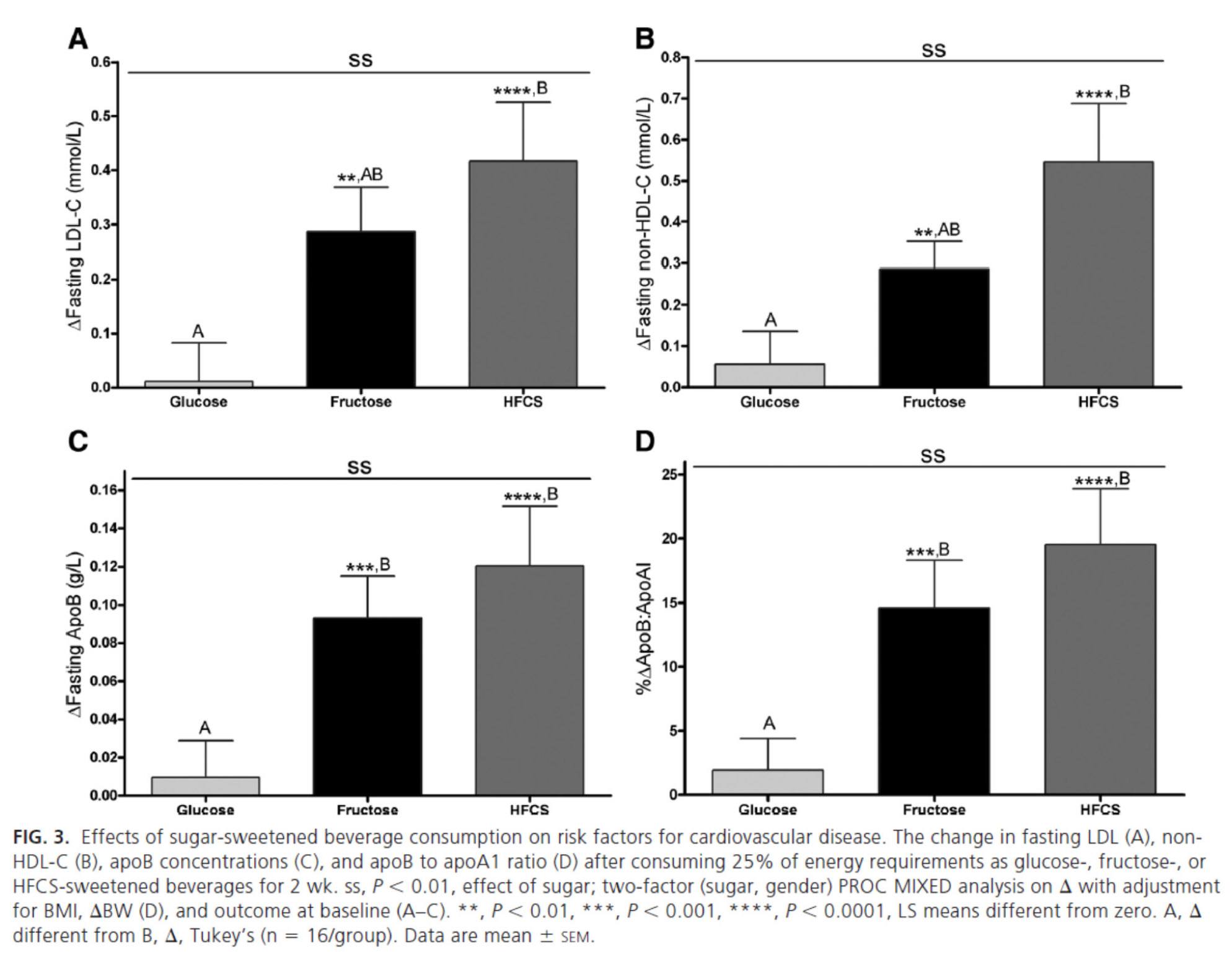
Again, the results were unmistakable with respect to the impact of fructose and HFCS on lipoproteins, and by extension, the relative lack of harm brought on by glucose in isolation. [Of course, removal of glucose and fructose/HFCS would have been a very interesting control group.]
One of the simultaneous strengths and weaknesses of this study was the heterogeneity of its subjects, who ranged in BMI from 18 to 35, in age from18 to 40, and in gender. While this provided at least one interesting example of age-related differences in carbohydrate metabolism (older subjects had a greater increase in triglycerides in response to glucose than younger subjects), it may have actually diluted the results. There were also significant differences between genders in the glucose group.
What was most interesting about this study was the clear difference between the 3 groups that was not solely a function of fructose load. In other words, the best outcome from a disease risk standpoint was in the glucose group, while the worst outcome was not in the all-fructose group, but in the 50/50 (technically 55/45) mixed group. This is a very powerful indication that while glucose and fructose alone can be deleterious in excess, their combination seems synergistically bad.
The role of saturated fat in cardiovascular disease
In the next week or two I’ll be posting an hour-long comprehensive lecture I gave at UCSD a few weeks ago on this exact topic. Rather than repeat any of it here, I’ll highlight one study that I did not include in that lecture. The study, Effect of a high saturated fat and no-starch diet on serum lipid subfractions in patients with documented atherosclerotic cardiovascular disease, published in 2003, treated 23 obese patients (average BMI 39) with known cardiovascular disease (status post coronary artery bypass surgery and/or stent placement) with a high-fat ketogenic diet. Because the study was free-living and relied on self-reporting, not all subjects had documented levels of elevated serum B-OHB. However, the subjects were instructed to avoid starch and consume 50% of their caloric intake via saturated fat, primarily in the form of red meat and cheese. There were no restrictions on fruits and vegetables, which may have accounted for the observation that not all subjects were ketotic during the 6-week intervention. In total, only 5 of the 23 patients achieved documented ketosis.
All of the subjects were on statins and entered the study at a goal LDL-C level target of 100 mg/dL, which may have been the only way the authors could get the IRB to approve such a study.
The table below shows the changes in lipoprotein fractions following the intervention (there was no control group):

This study was conducted during the height of the “outcry” over the Atkins diet. While most doctors reluctantly agreed that Dr. Atkins’ diet could reduce body fat, most believed it was still very dangerous. In the words of Dean Ornish, “Sure you can lose weight on a low-carb diet, but you can also lose weight on heroin and no one would recommend that!”
Fair point. In fact, the authors of this study acknowledged that they “strongly expected” this dietary intervention to increase risk for cardiovascular disease, which is why they only included subjects on statins with low LDL-C. However, as you can see from the table above, the authors were startled by the results. The subjects experienced a significant reduction in plasma triglycerides and VLDL triglycerides, without an increase in LDL-C or LDL-P. In fact, LDL size and HDL size increased and VLDL size decreased – all signs of improved insulin resistance. Furthermore, fasting glucose and insulin levels also decreased significantly. The mean HOMA-IR was reduced from 5.6 to 3.6 (normal is 1.0) and TG/HDL-C from 3.3 to 2.0 (normal is considered below 3, but “ideal” is probably below 1.0) in just 6 weeks. Taken together, these changes, combined with the dramatic change in VLDL size, suggest insulin resistance was dramatically improved while consuming a diet of 50% saturated fat!
As all of these patients were taking statins, we’re really robbed of seeing the impact of this diet on LDL-P, which did not change. Also, CRP levels rose (though not clinically or statistically significantly).
Putting it all together
It is very difficult to make the case that when carbohydrates in general, and sugars in particular, are removed or greatly reduced in the diet, insulin resistance is not improved, even in the presence of high amounts of saturated fats. When insulin resistance improves (i.e., as we become more insulin sensitive), we are less likely to have the signs and symptoms of metabolic syndrome. As we meet fewer criteria of metabolic syndrome, our risk of not only heart disease, but also stroke, cancer, diabetes, and Alzheimer’s disease goes down.
Furthermore, as this study on the Framingham cohort showed us, the more criteria you have along the spectrum of metabolic syndrome, the more difficult it becomes to predict your risk, due to a widening gap in discordant risk markers, as shown in this figure.
As I noted at the outset, the “dream” trial has not yet been done, though we (NuSI) plan to change that. Until then each of us has to make a decision several times every day about what we will and won’t put in our mouths. Much of this blog is dedicated to underscoring the impact of carbohydrate reduction on insulin resistance and metabolic syndrome.
The results of the trials to date, combined with a nuanced understanding of the lipoprotein physiology and their role on the atherosclerotic disease process, bring us to the following conclusions:
- The consumption of sugar (sucrose, high fructose corn syrup) increases plasma levels of triglycerides, VLDL and apoB, and reduces plasma levels of HDL-C and apoA-I.
- The removal of sugar reverses each of these.
- The consumption of fructose alone, though likely in dose-dependent fashion, has a similar, though perhaps less harmful, impact as that of fructose and glucose combined (i.e., sugar).
- The addition of fat, in the absence of sugar and starch, does not raise serum triglycerides or other biomarkers of cardiovascular disease.
- The higher the level of serum triglycerides, the greater the likelihood of discordance between LDL-C and LDL-P (and apoB).
- The greater the number (from 0 to 5) of inclusion criteria for metabolic syndrome, the greater the likelihood of discordance between LDL-C and LDL-P (and apoB).
I would like to address one additional topic in this series before wrapping it up – the role of pharmacologic intervention in the treatment and prevention of atherosclerotic disease, so please hold off on questions pertaining to this topic for now.


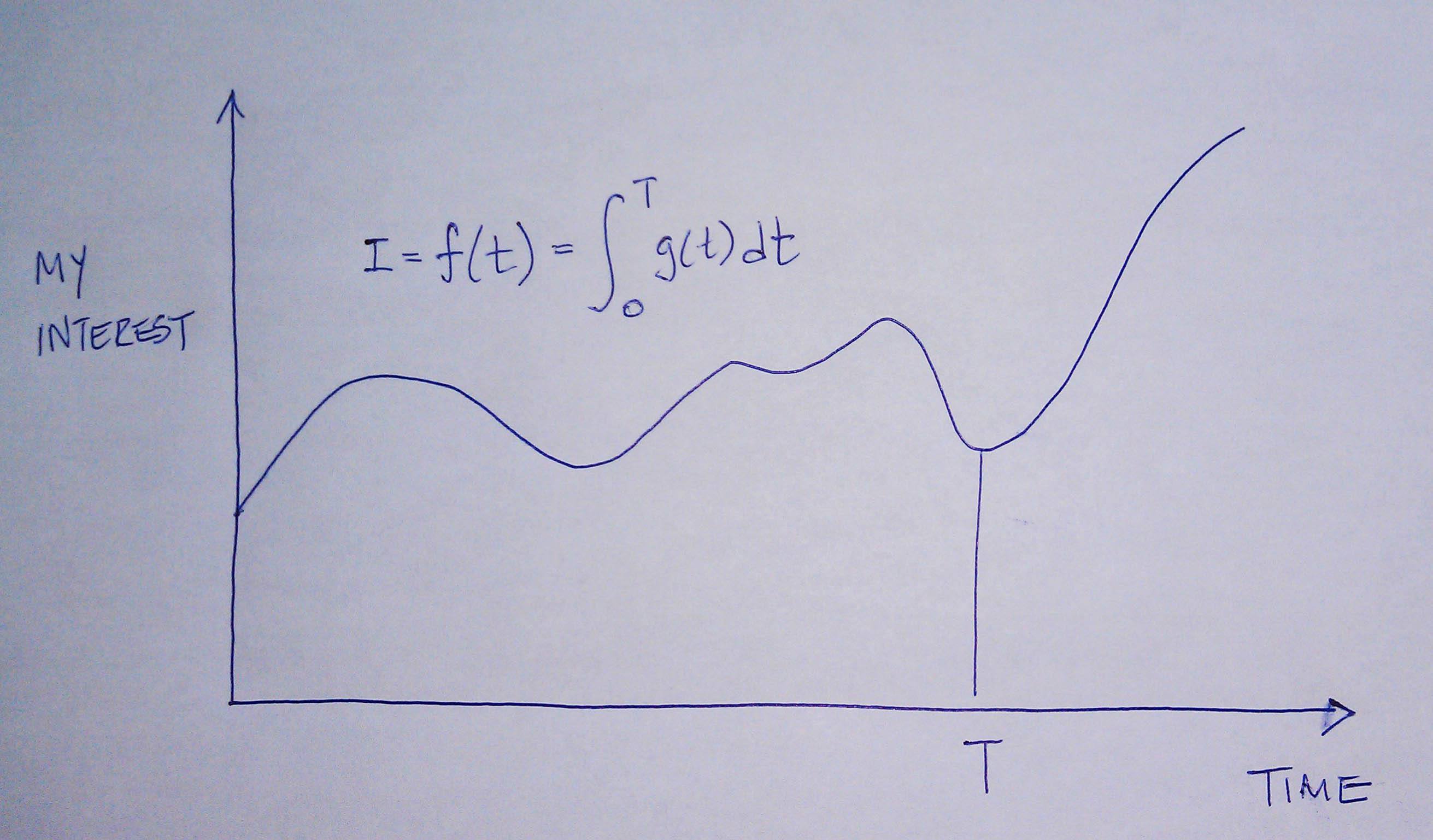
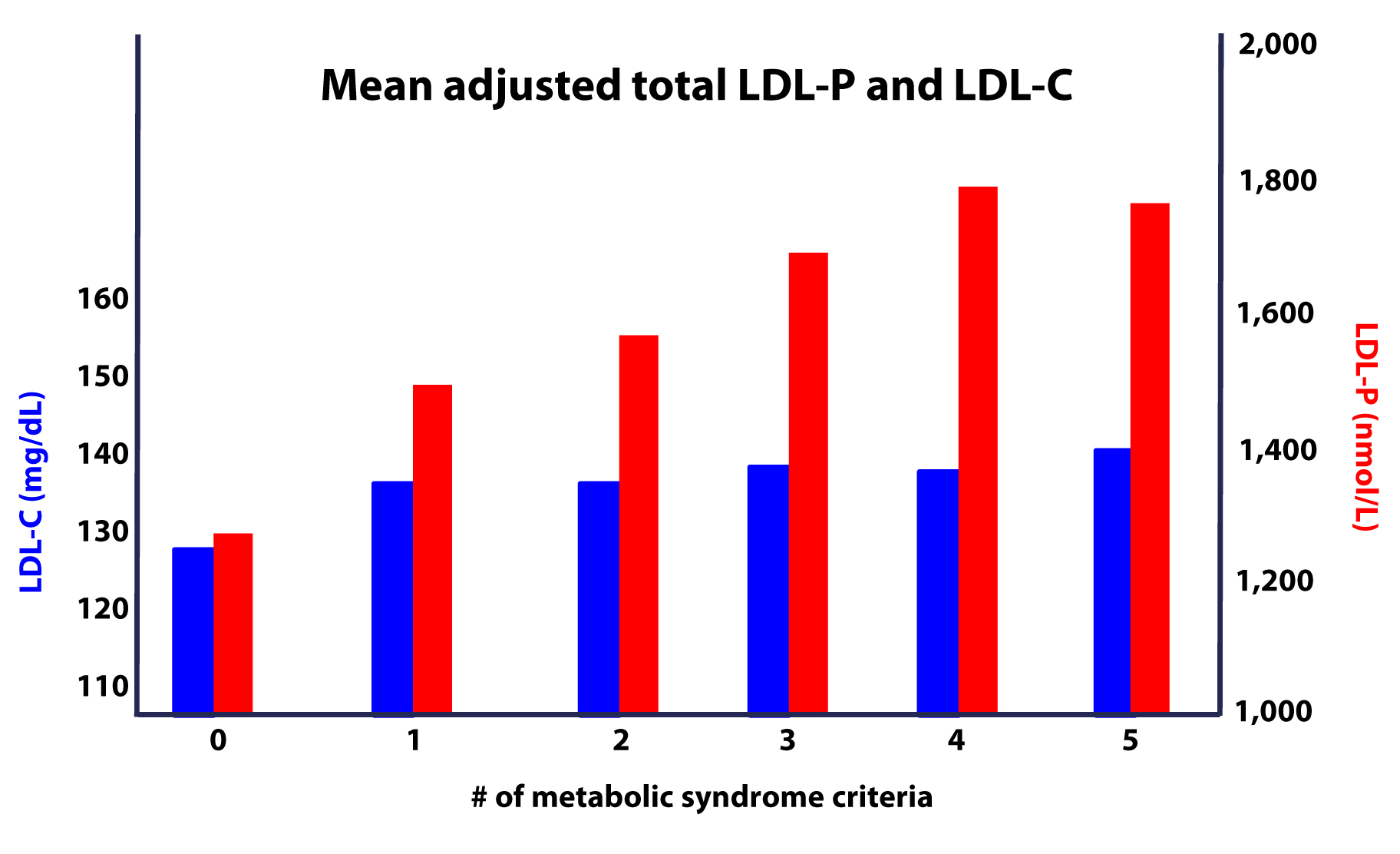
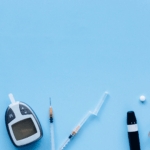
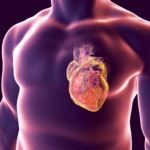
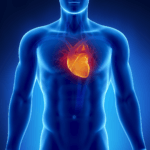

Hi Peter! Thanks again for your excellent work! You mentioned that there is only one more installment left; however, previously you mentioned that you planned to do a post on the Apolipoprotein E Genotype. Would this not be a cholesterol-related topic? I didn’t see it listed on your coming-soon page, so I am not sure if you still plan to cover it. Thank you so much for all of your hard work! I don’t mean to add to it 🙂
I may need to take a small break from the series after a “wrap up.” I will write about apoE eventually, but not in part X.
Would be interested in your take in this interview with Dr.Ron Kruass where he says sat fat raises LDL levels and small LDL-P is worse for CAD than large LDL-P:
https://www.meandmydiabetes.com/2010/03/26/ldl-cholesterol-ron-krauss-md/
My takeaway from your great series on cholesterol is that if LDL-P is at goal for a given person, the diet composition may not really matter since LDL-P causes CAD. Is this a correct conclusion? Thanks.
Size is a marker for risk, but at a given LDL-P or apoB it stops mattering. 2,000 large particles is just as bad as 2,000 small particles. In fact, 2,000 large particles is worse than 1,500 small particles. Check out the post where I review this concept with data. I think it was part III or IV, maybe V.
I read all your posts which are great. Just found it curious as to why Dr. Ron Krauss would seem to feel the small particles are worse. Since i do not know how to contact him I thought I would ask you.
Now if total particles is all that counts regarding CAD, and one is at the right LDL-P for their risk factors, does diet then really matter?
I can’t speak for him. There is a great deal of confusion around the difference between a something (e.g., small LDL-p) being prognostic of other problems (e.g., IR) vs. an absolute risk in and of itself.
I completely understand. An update: I found very thorough information on the HDL website.
Thank you so much for your comments and all of your posts and responses. Your series on cholesterol and “What I Actually Eat” are informative, thought provoking and make sense (even to a lay person such as me). Thank-you for such quick responses to questions. I consider your blog and reader responses as important as reading the morning newspaper. You most certainly deserve to take a break. But give us plenty of notice please, so the withdrawal won’t be too bad.
I was eating a lot of Omega-3 foods until that Omega-3 study that had to be ended abruptly, because a large percentage of the participants developed prostate cancer. I haven’t heard that mentioned here.
Any responses?
Please send over link to actual study. I’ve seen epidemiological data suggesting this, but not prospective data. Hard to draw conclusions for the former.
Dr. Gerhard Spiteller suggests it is because of these substances that a fish diet is beneficial while a fish oil supplement maybe is not so in comparison.
https://www.ncbi.nlm.nih.gov/pubmed/16296395
Furan fatty acids: occurrence, synthesis, and reactions. Are furan fatty acids responsible for the cardioprotective effects of a fish diet?
This doesn’t strike me as particularly compelling.
If a person is already on statins (not me; the brother-in-law), would the NMR LipoProfile still be useful? If he’s been on the statins a short time, a few weeks, is it still a good call to get the test? Maybe a good baseline to evaluate the effectiveness of the statins, if in his case it was the right call? I’m concerned he could be a one of those w/ confounding data, as his cholesterol is high, but TG are WNL and HDLs are quite good.
Absolutely, especially if combined with the sterol panel from HDL, Inc., as it gives more information about whether or not the statin is even indicated.
Now if total particles is all that counts regarding CAD, and one is at the right LDL-P for their risk factors, does diet then really matter?
Of course. The role of diet on cardiac disease is important, but there are many other reasons to consume an optimal diet. Even if LDL-P is ideal on a sub-optimal, other things could likely be improved.
Good afternoon Dr. Attia,
First I’d like to thank you for your tireless knowledge sharing. I expect wild success from NuSi.
Second, I would like to know when I can reasonably expect a post where you at least touch on the suitability and efficacy of a low-carb lifestyle for pregnant/nursing women, nursing infants and children. I’d be especially interested in whether a ketogenic diet would have any effect on women’s breast size, being that they are nearly all fatty tissue (as I understand them).
Third, I’d like to share something. This is a mini-lecture from a class I am taking in college called ‘Basic Weight Training for Life.’ I am wondering if you can name a single study (or even basic science) off the top of your head that would effectively argue against this, something I could reference in my rebuttal . I already know this to be patently untrue per your generous knowledge sharing, that of Gary Taubes and my own personal experience in transitioning to a low-carb lifestyle. (I am aware you can not respond to EVERY comment so if I do not receive an answer I will not harbor any negative feelings.)
“Carbs Are Good: No Carbs Mean Fatter Person – – We use food and stored food to make the energy we need to live, be active, and exercise. In aerobic metabolism, where copious amounts of energy can be converted to be used, the process begins with the breakdown of glucose. Glucose is our blood sugar or blood carb. Through a series of steps these glucose molecules produce some usable energy, but also leave a by-product substrate called pyruvate. The conversion of pyruvate in combination with oxygen, allows stored fat to be used as fuel substrate as well. To put it simply. Fat can only burn in the flame of carbohydrates. If you do not have carbs, you cannot burn fat. If you cut down on carb intake, you get fatter. Again, we are not talking about weight, but about fat. Muscle doesn’t weigh less than fat, it is more dense. At the same weight muscle takes up less room. That means you can tighten your belt a notch even though the needle on the scale does not move.”
Thank you,
Nicole
1. My pleasure. Looking forward to introducing NuSI to everyone.
2. Not sure…too many things in the mix right now, and I’d hate to make a promise I can’t keep.
3. Turn the tables on them. Ask them for proof of this statement.
This series has been nothing short of fantastic. You should… seriously… write a book. Your enthusiasm and straight-talking style are just what are needed. How about calling it «Everything You Know About Diet and Health is Wrong (and What You Need to Know to Eat Right and Minimize Health Risks)»
Just what I need…another project!
Dr. Attia – Just started reading your website really enjoy it. Quick question about my blood panel.
HDL- 58
LDL-196
VLDL -5
TG -24
I know my TG number is good and HDL is ok but I’m little worried that my LDL is so high
Little more information – I’m 33 , blood pressure is 112/68, am 6′ tall 183 pounds, exercise in short intense sessions 2-4 times a week and try and walk several miles day on off days. Get good sleep and eat basically way you have described yourself. I don’t eat any grains or vegetable oils or sugars. Mostly grass fed meat I buy direct from farmer, eggs, wild caught fish, coconut oil and some veggies and few berries.
Do you think the LDL number is a cause for concern? I realize you state numerous times its more about the LDL-C and LDL-P ratio just thought that number was pretty high and not sure why
Thanks
Tim, I can provide medical advice, unfortunately. A TG/HDL ratio of less than 0.5 is excellent, though.
I have been reading your site chiefly because of what appears to be a bad news lipid panel on my husband (high LDL, low HDL, high TG, and TG:HDL over 8). This is 5 years after a seemingly “good” panel. Good news is I asked for and got our doctor to order the NMR LipoProfile. You have recommended, from other posts, to combine this with a sterol panel from HDL, Inc. What is this sterol panel, and is such a panel not available from a lab other than HDL? We are able to get the NMR at LabCorp.
Also, just reading your explanation of discordance makes me think that even with a “good” standard lipid panel, such as I have, makes me concerned that even I should have the NMR. I mean, if a bad numbers aren’t necessarily bad, then good numbers can’t be relied upon to be good either?
RE the husband, his age, size, genetics, and athleticism (though not as intense) are fairly similar to the before-you. One of my mental problems about this, however, is that we already had de-emphasized carbs for several months; and we eat very low n6, grains or sugar; eat all grassfed & pastured meat, raw milk from grassfed cows, good vegetables, coconut oil and grassfed butter. He is on board with all that I do on the eating, he just eats a bit more fruit than I, but nothing excessive. In fact he eats less than I do, even though he outweighs me by about 160%.
It seems to me from all my reading on these issues, that he could be either (1) needing more carb-cutting – currently trying that out – or (2) he one of those who gets the “bad” numbers from the already low carb diet, as suggested by Westman and other readers here. When we get the NMR results, if by some chance the LDL-P is not so bad, then great. But if it’s high as I expect, then I would think more extreme carb-cutting is in order. Am I thinking straight here? And after how much time would you recommend trying that before re-testing?
Sorry for the long/multiple questions. I’ve been reading as much as I can, of articles and comments, saving up my thoughts.
Looking forward to your post about EPA and DHA!
Only Health Diagnostic Labs, Inc. (HDL, Inc.) does the sterol test. They send out to LipoScience for the NMR portion of the test and do all else in house.
I appreciate the depth of research in this post. Unfortunately I have not had success on a low-carb diet in terms of my lipid profile.
My Apo B, LDL-C, are extremely high. Apo B is 167. LDL-C is 245.
This was from a VAP test, which I sought out after the normal lipid panel scared me.
Trigs are ok (101), HDL is fair (50). LDL pattern is A.
Blood sugar and blood pressure are excellent, weight is good, I feel fine, and work-out 3 times per week. Why is my cholesterol so damn high?
My Doctor wants to put me on statins of course.
Can’t really address this, Matt. The only thing I can say, though, is the apoB here is calculated. It may not accurately represent a measured apoB or a measured LDL-P.
Hi Dr. Attia,
Glad to see your blog is up and running again. Your presentation provided me with such a clearer understanding of the science behind weight. Also, thanks for the Francis bacon reference. I am staring my masters and want a true take on the scientific method.
How about an update on NuSI? The lecture mentioned 3-4 weeks.
Thanks
Thanks, Ellen. We’re running full speed ahead with NuSI, but we’ve postponed our public launch until early September.
Dr. Attia, thank you for this. I’m very excited about your work. At this moment though, I just wanted to say that I for one would have swooned at such an explanation of your interest and time, though I may have argued that what I really wanted was frequent high peaks, not just a large aggregate.
Amber, where were the girls like you when I was in college?
I’ve linked to this post in my essay on calories vs carbs as drivers of Hepatic de novo lipogenesis:
https://hopefulgeranium.blogspot.co.nz/2012/07/what-does-hypercaloric-actually-mean.html
Great post, George.
Correct me if I am wrong but I don’t think that you have shown points 1. and 2. What the data show is that fructose, in the context of a high carbohydrate diet raises TAG. Isn’t this just as well described as the effect of high glucose on other parameters.
This is the point of my latest blog post at https://wp.me/16vK0 which examines a similar study from Havel’s group.
Richard, great to have you commenting on this blog. [For those who don’t know Richard, he’s a world-class scientist who has been studying this topic for many years.] You are correct, my conclusions are in the context of a “Standard American Diet.” In the context of a LCD, especially when hepatic stores of glycogen are depleted, fructose will be preferentially converted to glycogen (as you know, but many may not, at a rate that exceeds that of glucose conversion to hepatic glycogen). Thanks for making the distinction for the readers. If you’re going to be in Boston for AHS, I hope we can meet in person.
Dear Peter,
Thank you so much for writing this marvelous series on cholesterol! I went to UCSF to become a nurse-midwife and I’ve learned as much from this series as from some entire classes in grad school. It is so well-explained and I’ve learned a tremendous amount that I didn’t know before. I have a couple of questions–
1. It seems to me from reading the series and checking out many of the studies you mention that we should just replace the standard profile with this improved way of testing, since the LDL-C is not a great predictor and the LDL-P is a great predictor. But in reading the comments I see that you perhaps agree with some who say we should not do that, but should only use the NMR for certain people (or maybe you were bending over backwards to be reasonable but lean towards thinking we should switch over for everyone too). It seems to me that if this became the standard the cost would probably come down over time as it became more common. But more importantly, since some degree of insulin resistance probably characterizes most adults in the U.S., it seems to me that the standard profile would not be the best idea for at least a majority (if not all) of the patients. I suppose you could identify people who were concordant with the NMR and then plan to do their future screenings with the cheaper test, but that would assume they weren’t developing insulin resistance over the following years and that they would stay concordant.
2. Do we know why there is a lot of discordance between the 2 measures in insulin-resistant people? At first I was thinking it was due to the calculation for the LDL-C being dependent on triglycerides but then I see in the example of an NMR report that the LDL-C and LDL-P are discordant and the triglycerides are not high.
Thank you again for writing this incredible series!!!
Jennifer, it probably does not make sense to use NMR as the standard lipid test for everyone. For starters, there is only one company in the world that can do the test, and they wouldn’t be able to test even 5% of the US population. But even if the test was readily available, on average, it may not make sense for every single person to get the test. Of course, on a personal basis, it’s harder to make that claim. We all want perfect information for ourselves. To your second question, the biggest driver of discordance is probably the over-abundance of TG in lipoproteins at the expense of CE — driven most often (but not always) by IR.
I just got a call from my internist and we discussed my labs and lipids results. I’m about doing the happy dance because (1) TG of 48, with a TG:HDL 0.58; and (2) after telling her why I was not concerned about what she felt was high cholesterol and LDL-C, my doctor said, “You know more than I do.”
Thank you Dr. Attia, for your generous education. You have helped me immeasurably, and I’d go so far as to say you are helping me save my husband’s life. He had blood drawn today for the NMR-LP and LP-IR, is losing weight, and complying with a VLCHF diet. As a bonus I’m hoping our internist will learn a bit and be able to help other patients. Further, I spread your blog to anyone who’ll listen!
If only more doctors had this level of humility and curiosity, the world would be a better place.
Not sure which cholesterol post this question fits most appropriately (hope you haven’t answered a million times). I know you recommend NMR when checking cholesterol, so that was one of the tests on my list that I requested the doctor run when I was in last week. He said that unfortunately the lab he works with does VAP tests and not NMR, but agreed the NMR was the best. I asked him if the VAP measured number of particles and he didn’t really answer the question he just said it was also a really good test and would tell me about particle size etc. Of course, from reading your post, I know that it’s the number of particles I need to be concerned about! I’ve searched in vain online and I can’t seem to find the answer. There are a number of people on my mom’s side of the family with pretty early heart disease (early 50’s) and though I have a couple of decades, I’d just like to be sure I’m on the right track even now! Hoping the VAP test isn’t completely worthless!
Hmmm, the VAP really isn’t an adequate test, as it doesn’t even measure apoB (it estimates it). At least see if you doctor can do a Berkeley labs apoB test, or go better yet, see if he/she can go through HDL, Inc for the NMR (rather than directly through Liposcience).
Peter:
Was wondering if you had a chance to read the research just published by Western University Dr. David Spence claiming that eating egg yolks is almost as harmul as smoking as it relates to atherosclerosis, and what your thoughts were on it?
Addressed in 4 other comments. What are your thoughts on it, now what you’ve hopefully been educated on i) cholesterol and the pathogenesis of atherosclerosis, and ii) bad science?
I would like a response to the study published by Western University Dr. David Spence claiming that eating egg yolks is almost as harmful as smoking as it relates to heart disease, and I didn’t see any on this website.
Yes sir! I’m so sorry I don’t have one up. Will you forgive me? Pardon the sarcasm, but the tone of your question — demanding and entitled — really rubs me the wrong way. I apologize if I’m misreading it.
If you want a response to this, you should read the multiple posts on cholesterol. You should also read the posts that talk about poorly done research, of which this study is classic example. You may even want to read the summaries of others, which I’ve already referenced 7 or 8 times in the past 3 days. Jack – let me blunt – you’ve got to learn to think for yourself. I don’t write the blog because I’m board and have too much time on my hands. I write it to TEACH you how to think critically. This would be a good time for you to start putting those skills into practice. You should be the other readers on this site why this study is flawed.